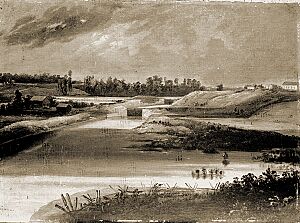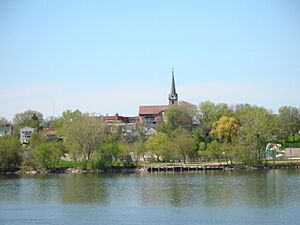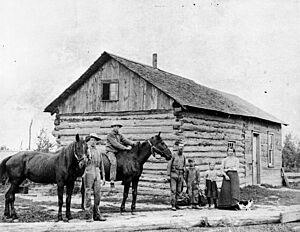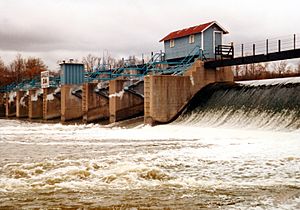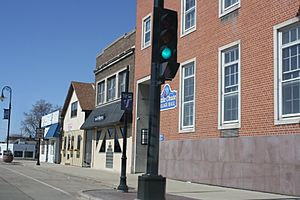Little Chute, Wisconsin facts for kids
Quick facts for kids
Little Chute, Wisconsin
|
|
|---|---|
|
Village
|
|
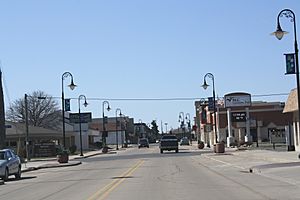
Downtown Little Chute
|
|
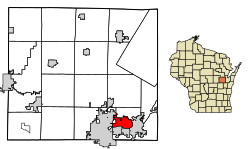
Location of Little Chute in Outagamie County, Wisconsin
|
|
| Country | |
| State | |
| County | Outagamie |
| Area | |
| • Total | 6.78 sq mi (17.56 km2) |
| • Land | 6.45 sq mi (16.71 km2) |
| • Water | 0.33 sq mi (0.85 km2) |
| Elevation | 732 ft (223 m) |
| Population
(2010)
|
|
| • Total | 10,449 |
| • Estimate
(2019)
|
12,081 |
| • Density | 1,872.44/sq mi (722.92/km2) |
| Time zone | UTC-6 (Central (CST)) |
| • Summer (DST) | UTC-5 (CDT) |
| ZIP code |
54140
|
| Area code(s) | 920 |
| FIPS code | 55-44950 |
| GNIS feature ID | 1568226 |
Little Chute is a village in Outagamie County, Wisconsin, United States. In 2010, about 10,449 people lived there. It is located just east of the city of Appleton, Wisconsin and sits along the Fox River. Little Chute is part of the larger Appleton area.
The town was first set up as a trading post by French explorers. They called it "Le Petite Chute," which means "Little Chute." Later, in the late 1800s, many Dutch Catholic immigrants from the Netherlands settled here. They were led by a missionary named Theodore J. van den Broek. Little Chute became an important place for Dutch Catholic families in the Midwest. Today, you can visit a real Dutch-style working windmill in Little Chute, which is a popular tourist spot.
Before Europeans arrived, the Mississippian culture tribe, the Oneota, likely lived in this area. The Oneota are thought to be the ancestors of the Ho-Chunk tribe. There is a historical marker near Little Chute that remembers the Treaty of the Cedars. This treaty gave 4 million acres of Native American land to the U.S. government.
Contents
History of Little Chute
Little Chute's history is shaped by two main things: the fast-moving waters (rapids) and portages (places where boats had to be carried) along the Fox River, and the arrival of Dutch-Catholic settlers in 1848.
Native American History
There isn't much left today of the very first Native American communities here. Before Europeans came, the Oneota tribe, part of the Mississippian culture, probably lived in the area. The Oneota are believed to be related to the Ho-Chunk people. The Ho-Chunk tribe was very strong in this area when the French first arrived. The Menominee tribe lived just to the north.
Later, the Sauk and Meskwaki peoples moved into the Fox River Valley. They eventually pushed most of the Ho-Chunk out. When the first French settlers arrived, they named the river after the Fox tribe. The county where Little Chute is today was named Outagamie, after the Meskwaki (who the French called Outagamie).
The rapids on the Fox River near Little Chute made it hard for canoes to pass. The Sac tribe even set up "toll stations" there. The French were upset by this, so they fought a series of wars called the Fox Wars. This drove the Sac out of the area by 1742. After this, the Menominee tribe briefly became very strong in the area. They built a village called Ookicitiming near where Little Chute is now.
First European Settlers
The first Europeans in the area were the French. Jean Nicolet reached the Fox River at Green Bay in 1634 and started a trading post. Explorers Father Jacques Marquette and Louis Joliet traveled through the area in 1673. They used the canoe route to get to the Mississippi River.
Around 1760, French Canadian families like Augustin and Charles Grignon started a fur trading post near the rapids. Even though French influence later faded, you can still see it in local names. For example, the three main rapids on the Fox River were called “La Grand Kauklin,” “La Petite Chute” (which is now Little Chute), and “La Grand Chute.”
The area was controlled by the French until 1763, then by the British, and finally by the Americans after 1781. Wisconsin became a state in 1848.
Father Van den Broek and the Dutch Settlers
A very important person in starting Little Chute as a Catholic Dutch-American community was a missionary priest named Father Theodore J. van den Broek. He was born in the Netherlands in 1784 and was very educated. In 1836, he came to La Petite Chute. There, he built the first church for the Menominee Indians, called St. John Nepomucene.
Father Van den Broek wrote letters to groups in the Netherlands about the area. These letters appeared in a Catholic newspaper. In 1847, he went back to the Netherlands. He wrote more letters, inviting people to come to La Petite Chute. He talked about the land and jobs building the Fox River Canal. He even offered free travel to America for workers.
Many people responded! By 1848, three sailing ships carried about 918 Dutch Catholic immigrants to the United States. Most of them came from villages near Uden in the Netherlands. They were looking for better economic opportunities.
The trip to La Petite Chute was long. It involved sailing across the Atlantic Ocean, then taking trains and steamboats through New York and the Great Lakes. Finally, they traveled by ox-cart from Green Bay to La Petite Chute.
The first group arrived on May 22, 1848. Father Van den Broek's group arrived on June 10, 1848. The immigrants found mostly forested land, not plowed fields as they might have expected. There wasn't enough good land for everyone from Father Van den Broek's own land. Some families, led by Cornelis van de Heij, left to start the village of Holland (also called “Hollandtown”). Other Europeans, like French and Irish immigrants, were already living in La Petite Chute, which was now also called “Little Chute.”
Growth of the Dutch Community
Even with challenges, the village grew. More Catholic Dutch immigrants came from all over the Netherlands. Whole families and neighborhoods moved to join their relatives and friends already in Little Chute and nearby farming areas. It's thought that by 1927, about 40,000 Dutch Roman Catholics had moved to the United States. Little Chute and the surrounding area became the largest group of Catholic Dutch immigrants.
St. John Nepomucene Church was a very important center for the community. The first settlers worked hard to clear land, plant crops, and build homes. The Fox River Canal system was completed by 1856. Railways also arrived, and steamboat lines were set up. The water power from the falls was used for mills. Little Chute got its own post office in 1849. In 1899, Little Chute officially became a village.
While other Dutch American towns were mostly settled by Protestants, Little Chute was mainly settled by Catholics. By the early 1900s, it was the biggest Catholic Dutch community in the U.S. People in Little Chute continued to speak Dutch, often called "speaking Hollander," well into the 20th century. Even in 1898, church sermons were in Dutch. The Dutch festival of Sinterklaas was celebrated as "St Nick’s Day" on December 6, a tradition that many families still follow today.
Little Chute Today
Little Chute used to celebrate the Dutch festival of Kermis every year from 1981 to 2015. St. John Nepomucene is still a busy church and school today.
Little Chute is home to a full-size, real working Dutch windmill. It's run by a non-profit group called Little Chute Windmill. The Little Chute Windmill and Van Asten Visitor Center, finished in 2013, is a museum and tourist spot. It teaches visitors about the community's history and Dutch heritage.
The Fox River Navigational System Authority is working to fix and operate the system of locks on the Lower Fox River. This includes the locks in Doyle Park in Little Chute.
While some homes have windmills and other Dutch decorations, the Dutch language is not spoken much anymore. However, a tradition from the Netherlands called "De Schut" (a copy of "Koningsschieten") still happens every year in Little Chute.
The Fox-Wisconsin Heritage Parkway is a non-profit group that is fixing up the Little Chute Lock Tender's House. This house is on the National Register of Historic Places and will become a vacation rental.
Geography of Little Chute
Little Chute is located at 44°17′03″N 88°18′49″W / 44.284087°N 88.313629°W.
The village covers a total area of about 5.52 square miles (14.3 square kilometers). Of this, 5.16 square miles (13.36 square kilometers) is land, and 0.36 square miles (0.93 square kilometers) is water.
Little Chute is the largest village in Outagamie County.
Population Information
| Historical population | |||
|---|---|---|---|
| Census | Pop. | %± | |
| 1890 | 380 | — | |
| 1900 | 944 | 148.4% | |
| 1910 | 1,354 | 43.4% | |
| 1920 | 2,017 | 49.0% | |
| 1930 | 2,833 | 40.5% | |
| 1940 | 3,360 | 18.6% | |
| 1950 | 4,152 | 23.6% | |
| 1960 | 5,099 | 22.8% | |
| 1970 | 5,522 | 8.3% | |
| 1980 | 7,907 | 43.2% | |
| 1990 | 9,207 | 16.4% | |
| 2000 | 10,476 | 13.8% | |
| 2010 | 10,449 | −0.3% | |
| 2020 | 11,619 | 11.2% | |
| U.S. Decennial Census | |||
2010 Census Details
In 2010, Little Chute had 10,449 people living in 4,207 households. The population density was about 2,025 people per square mile (782 people per square kilometer).
Most of the people (94.8%) were White. About 3.1% of the population was Hispanic or Latino.
The average age in the village was 37 years old. About 24.5% of the residents were under 18 years old.
Transportation
The Tri-County Expressway (Wisconsin Highway 441) runs on the west side of the village. Interstate 41 is on the north side. It connects Little Chute to Green Bay to the north and Appleton, Oshkosh, and Milwaukee to the south.
Bus service is provided by Valley Transit. The Appleton International Airport serves Little Chute for air travel. The village of Little Chute is in charge of maintaining over 53 miles of roads.
Education
Little Chute has both public and private schools. St. John's is a private school for grades K–8. The public schools serve students from kindergarten through 12th grade. Grades 5–12 of the public school are located in different parts of the same building.
Religion
St. Luke Lutheran Church, which is part of the Wisconsin Evangelical Lutheran Synod (WELS), is located in Little Chute.
Notable People
- Clarence Currie, a baseball player
- Johnny Van Cuyk, a baseball player
- William N. Vander Loop, a Wisconsin State Representative
- J. H. M. Wigman, a mayor of Green Bay, Wisconsin
Fictional Characters
- Amanda Ripley, a main character from the video game Alien: Isolation. Little Chute is also where Amanda and her mother, Ellen Ripley from the Alien movies, are said to be buried.
- Mike Nelson, a main character played by actor and comedian Michael J. Nelson in the TV show Mystery Science Theater 3000.
See also
 In Spanish: Little Chute (Wisconsin) para niños
In Spanish: Little Chute (Wisconsin) para niños


